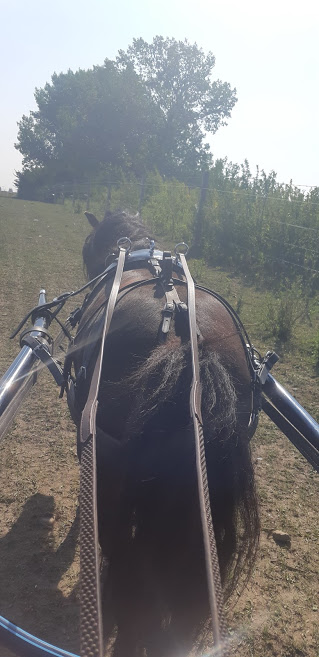If you’ve driven a Miniature Horse any amount of time at all, you’ve probably dealt with a crooked horse.
We’ve all been there, struggling to get their head going in the same direction as the rest of their body.
While this is a concern with all horses and disciplines, as all horses, just like humans, have a stronger side that they favour, I believe it’s even more common in Miniature Horses, as when driving we’re asking them to not only balance themselves, but also a load that is often equal to or greater than their own weight. They’re capable of doing what we ask, for sure, but we can help them out by making it as easy for them as possible. And one of the ways we can do that is by helping them be balanced and straight.
What does straight mean?
Straight doesn’t mean that we want them to be in a perfectly straight line from ears to tail all the time. In fact, we absolutely DON’T want that. We want them to be straight in the direction of travel, with weight equally distributed and well balanced. That means that if we’re turning to the left, they should be bent to the left, along their path, not travelling left with their head turned right, which is a very common issue.
How can we help?
There are a number of contributing factors that may be involved a horse who is struggling with straightness, and depending on what the cause is it might be a quick and easy fix, or take some time. But here’s some things to try!
Rule out pain first.
We tend to always assume a training issue first, when it could be that our horse has a physical reason they’re not able to do what we’re asking. We should always look for an injury or other source of potential pain before trying to “fix” anything with training. Get their teeth examined for any potential issues, recheck harness fit and comfort, have a lameness exam performed, try a massage treatment. If we’re going to have a performance horse working at the top of their game, it’s always going to be a team effort, and your vet, farrier and bodyworker are a key part of the team.
It’s not them, it’s you.
When it comes to crookedness in our driving horses, we need to look to ourselves before we blame our horses. It’s nearly always us. When I’m struggling with a horse who wants to counterbend, the more I try to “fix” it the more I end up with my body and theirs contorted and the problem worse than ever. But if I remember to stop, breath, roll my shoulders back, and drive from my core instead of my hands, things get better immediately. It’s always me making it worse by trying too hard to fix it. And chances are, it’s always you too.
Bending is weightlifting.
Like we wouldn’t expect ourselves to benchpress a hundred pounds on the first day we go to the gym, we can’t expect our horse to be able to carry themselves and a cart and driver in balance on a tight circle until they’ve had a chance to gradually build the strength to do so. Start with straight lines, big circles and wide, gentle turns until your horse has a change to get stronger, then gradually ask for more bend, smaller circles and sharper turns. Remember that the inside hind leg should be reaching well underneath their body in a correct bend – if that leg is sticking into the middle of the circle, then they’re not in balance and a bigger circle would be better for them at this stage of fitness.
No rush.
When you’re working to build a strong, balanced driving horse who can perform to their most brilliant potential, speed is not your friend – in two ways.
First, faster steps are a sign of imbalance and won’t help them build the right muscles they need to get better and better. A steady rhythm and longer steps are going to be much more beneficial – rushing is simply a sign they’re not yet strong enough for what you’re asking.
And second, changes don’t happen overnight. Quick fixes and gimmicks might show you a difference in the short term, but for your horse to truly be their best you have to allow them time to learn to carry themselves and build the fitness to to it well. Go slow, and I promise you’ll get there faster.
Just the beginning
Being aware that your horse is struggling with bending and straightness is the first step. Checking their physical comfort, your own balance, and giving them the tools and time to get stronger are the basic ingredients, but as every horse is an individual, your approach and conditioning plan will need to be tailored to what they tell you along the way.
If you’d like to learn more, my Improving Your Miniature Driving Horse course will starting on March 1st – Click here to learn more about the course!

Thanks Kendra! This is one of the areas I struggle with the most. Straightness is a difficult challenge for a lot of us. Mine I believe is part of me rushing when I’m out driving. My mind and body go at such a fast pace all the time.
I’ve been working on slowing myself down (Slowing My Roll!). I’m naturally go out there and get’er done kind of person, and as a result so is my mini. I’m starting with me first, and then working on ways to slow him down as well. This has helped me start working on our straightness issues.
Stay healthy and safe!
I struggle with that too – zoom zoom is just so much fun! 🙂
Your Improving your Miniature Driving Horse course is excellent. I revisit the modules often and I’m looking forward to your March offering of the course. Just in time for Spring driving😀